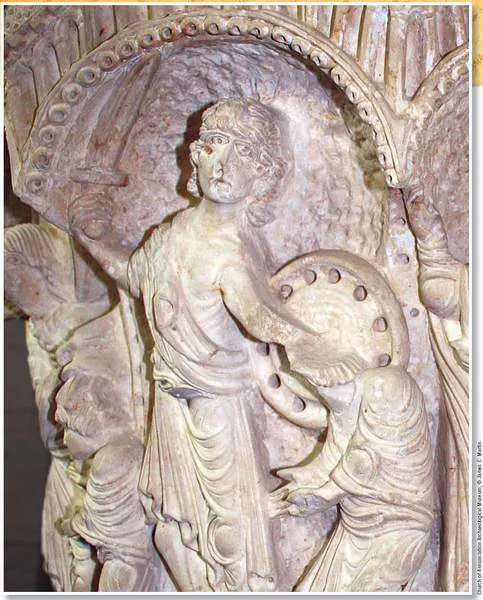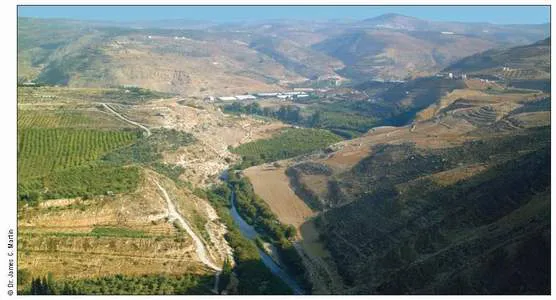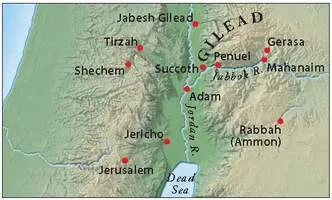![]()
J
This capital from the 11th or 12th cent. A.D. depicts the beheading of James.
J (Jahwist) yah’wist. An abbreviation for Yahwist (German Jahwist); it is used (along with D, E, and P) to designate one of the supposed sources of the PENTATEUCH, according to the Documentary Hypothesis.
Jaakan jay’uh-kan (
[not in NIV]). KJV Jakan. Son of E
ZER and grandson of S
EIR the H
ORITE; he probably became the progenitor of a clan in E
DOM (1 Chr. 1:42 NRSV, following MT). On the basis of some Hebrew
MSS and the parallel passage (Gen. 36:37), many scholars emend
ya(ăqān to
wa(ādqān (“and Akan”; cf. NIV). See also B
EEROTH-BENE-JAAKAN and B
ENE J
AAKAN. Jaakanite jay-a’kuh-nit. See BEEROTH-BENE-JAAKAN.
jay-uh-koh’buh
H3621, “[God] protects”; see J
ACOB). A clan leader in the tribe of S
IMEON (1 Chr. 4:36). He is listed among those whose families increased greatly during the days of King H
EZEKIAH and who dispossessed the Hamites and Meunites near G
EDOR (vv. 38 – 41).
Jaala jay’uh-luh (
H3606, variant
H3608, “mountain goat”). Also Jaalah. A servant of S
OLOMON whose descendants returned from the
EXILE (Ezra 2:56 [KJV, NRSV, “Jaalah”]; Neh. 7:58; 1 Esd. 5:33 [KJV, “Jeeli”; NRSV, “Jaalah”]).
Jaalah jay’uh-luh. See JAALA.
Jaalam jay’uh-lam. KJV form of JALAM.
Jaanai jay’uh-ni. KJV form of JANAI.
Jaar jay’uhr (
H3625, “forest”). The name of a place that, along with E
PHRATHAH, was associated with the
ARK OF THE COVENANT (Ps. 132:6; KJV, “the wood” [cf.
LXX]). Jaar is generally regarded as a (poetic) short form of K
IRIATH J
EARIM (meaning “town of forests”), where the ark remained twenty years before D
AVID brought it to Jerusalem. Some believe that the name was applied to a wooded area in the environs of Kiriath Jearim. It is possible that in this passage Ephrathah does not refer to B
ETHLEHEM specifically, but to a larger area that extended as far N as the border between the tribes of Judah and Benjamin.
E. RUSSELL
Jaare-Oregim jay’uh-ree-or’uh-gim (
H3629, “forests of weavers” [but scribal error suspected]). Father of Elhanan; the latter is described as the killer of G
OLIATH the Gittite (2 Sam. 21:19). Jaare-Oregim is apparently called J
AIR in the parallel passage (1 Chr. 20:5). For possible solutions to the discrepancies between these two verses, see E
LHANAN. Jaareshiah jay’uh-ree-shoi’uh (
H3631, “Yahweh plants”). KJV Jaresiah. Son of Jeroham and descendant of B
ENJAMIN; he is listed among the heads of families who lived in Jerusalem (1 Chr. 8:27).
Jaasau jay’uh-saw. KJV form of JAASU.
Jaasiel jay-ay’see-uhl (
H3634, “God makes [or carries out, or treats well]”). KJV Jasiel. (1) Son of A
BNER (S
AUL’S cousin); he was made an officer over the tribe of B
ENJAMIN during the reign of D
AVID (1 Chr. 27:21).
(2) A MEZOBAITE, mentioned last among David’s mighty warriors (1 Chr. 11:47). Some scholars emend “Mezobaite” to “from Zobah.” It has also been suggested, but without good reason, that this Jaasiel is the same as #1 above.
Jaasu jay’uh-soo (
H3632 [
Qere ], possibly “[God] treats well”; see J
AASIEL). KJV Jaasau. One of the descendants of Bani who agreed to put away their foreign wives (Ezra 10:37).
Jaazaniah jay-az’uh-ni’uh (
H3280, variants
H3279 [Jer. 35:3; Ezek. 11:1] and
H3471 [Jer. 40:8], “Yahweh listens”; see J
EZANIAH). The name appears on a number of ancient archaeological remains, showing that it was common in OT times.
(1) A military commander identified as “the son of the Maacathite”; he was among the officers who went to MIZPAH to join GEDALIAH, the governor appointed by the Babylonians after the fall of Jerusalem (2 Ki. 25:23; Jer. 40:8 [KJV, NRSV, “Jezaniah”]). It is usually thought that Jaazaniah belonged to the family that descended from MAACAH, CALEB’S concubine (1 Chr. 2:48), but there are other possibilities. Some speculate that this is the Jaazaniah whose name is inscribed on a seal discovered in Mizpah (modern Tell en-Naṣbeh; see M. Cogan and H. Tadmor, II Kings, AB 11 [1988], 326).
(2) Son of Jeremiah (not the prophet), a leader of the RECABITES, whose loyalty to their ancestral precepts the prophet JEREMIAH used as a lesson to his own countrymen (Jer. 35:3).
(3) Son of Shaphan and, apparently, a prominent elder in Jerusalem at the time of the EXILE; he is the only one mentioned by name among the seventy elders of Israel whom EZEKIEL, in a vision, saw offering incense to idols (Ezek. 8:11).
(4) Son of Azzur; he and Pelatiah son of Benaiah were leaders of the people in Jerusalem at the time of the exile, and Ezekiel was commanded to prophesy against their sin (Ezek. 11:1).
Jaazer jay’uh-zuhr. KJV alternate form of JAZER (Num. 21:32; 32:35).
Jaaziah jay’uh-z
i’uh (
H3596, “Yahweh nourishes”; see J
AAZIEL). Son of M
ERARI and grandson of L
EVI; he is not mentioned in most of the genealogies (e.g., Exod. 6:19), but only in a list of Levitical families that served during the time of D
AVID (1 Chr. 24:26 – 27). The Hebrew text is difficult, however, and some regard it as a later gloss (e.g., KD,
Chronicles, 259 [on 23:23]).
Jaaziel jay-ay’zee-uhl (
H3595, “God nourishes”; see J
AAZIAH). One of the Levites who played the lyre when the
ARK OF THE COVENANT was brought to Jerusalem (1 Chr. 15:18; called A
ZIEL in v. 20; some also identify him with the first J
EIEL listed in 16:5).
Jabal jay’buhl (
H3299, possibly “[God] leads” or “wanderer”). First son of L
AMECH by A
DAH; he was “the father of those who live in tents and raise livestock,” meaning probably that he originated the profession of herding animals, which often required the nomadic lifestyle of constant travel in search of pasture (Gen. 4:20). The word for “livestock”
(miqneh H5238), which more generally means “possessions,” may be a wordplay on the name of his ancestor C
AIN (qayin H7803). Less likely is the suggestion that the name Jabal alludes to A
BEL, the first shepherd. See also J
UBAL. Jabbok jab’uhk (
H3309, prob. “overflowing”). A river in T
RANSJORDAN (Nahr ez-Zerka, “river of blue”), about 60 mi. in length and, next to the Y
AR-MUK River, having the greatest drainage area in that region. It is a perennial stream, deriving from the 28 – 32 in. of rainfall annually. Its average fall is c. 80 ft. per mi., cutting a deep valley or gorge through the E J
ORDAN Valley escarpment. The source lies in the vicinity of modern Amman (ancient R
ABBAH of A
MMON, and Hellenistic Philadelphia), from whence it swings eastward and northward, forming a large loop before wending westward to the Jordan Valley. The lower gorge is under sea level to a point 7 mi. E of the rift, at an elevation of more than 2,000 ft. below the Gilead Plateau to the N and the Amman Plateau to the S. Colorful oleanders line most of its banks in the hill country. After emerging into the Jordan Valley near Tell Deir
(Alla (prob. ancient Succoth), it meanders across the Ghor before joining the Jordan River near ed-Damiyeh (biblical Adam).
The Jabbok River valley looking W.
The loop N of Amman formed the W boundary of the Ammonites at the time of the conquest (Num. 21:24), and the contained area was settled by the tribe of GAD, as far W as present es-Salt. The western part of the river formed a physical and political boundary between the two parts of GILEAD (Deut. 3:12, 16; Josh. 12:2 – 6), and also divided the kingdoms of SIHON and OG. Nelson Glueck found numerous occupation sites in the Wadi ez-Zerka in his surveys, and several biblical cities were located on, or near, its course. The specific ford referred to in Gen. 32:22 has not been identified, but the nearby site called Peniel (v. 31) is probably Tell edh-Dhahab esh-Sherqiyeh, about 8 mi. E of the Jordan; see PENUEL (PLACE). (See D. Baly, The Geography of the Bible [1957], 229; E. Orni and E. Efrat, Geography of Israel [1964], 91 – 94; Y. Aharoni, The Land of the Bible: A Historical Geography, rev. ed. [1979], 34, 38, 327.)
M. H. HEICKSEN
Jabesh jay’bish (
H3314, “dry”). Father of King S
HALLUM of Israel, who murdered King Z
ECHARIAH and usurped the throne (2 Ki. 15:10, 13 – 14). However, since the name Jabesh
(yābēš H3315) is also a short form of J
ABESH G
ILEAD, the expression “son of Jabesh” may mean “a native of Jabesh [Gilead].”
S. BARABAS
Jabesh Gilead jay’bish-gil’ee-uhd (
H3316, “dry place of Gilead”; also referred to simply as
H3315). A city in N T
RANSJORDAN (see G
ILEAD). The first mention of Jabesh Gilead comes at the end of a long story beginning in Jdg. 19 and continuing to the end of ch. 21. Briefly told, a Levite and a concubine, after spending some time with her people in B
ETHLEHEM, made their way N. They stopped for the night in G
IBEAH, where an old man entertained them. In the course of the night, the Levite yielded to the sadistic cravings of the men of Gibeah and gave to them his concubine. In the morning she was dead on the doorstep, so the
Levite dismembered her and sent the parts around the country. This incident started a war between BENJAMIN (of which Gibeah was a part) and the other Israelite tribes. The battle was indecisive for a while, but finally the Benjamites were defeated and almost completely annihilated. Because no one from Jabesh Gilead had fought against Benjamin, the Israelites went and slaughtered all but 400 eligible virgins in the city, and these were given to 400 surviving soldiers of Benjamin for wives. The 200 others were given permission to seize girls as they danced at the annual SHILOH festival (Jdg. 21:23). Apparently the town of Jabesh was repopulated by neighboring Gileadites.
The next episode centering on Jabesh is recorded in 1 Sam. 11, where the Ammonite NAHASH attacked the town. The only peace treaty acceptable to Nahash was that he gouge out one eye from each man of Jabesh. During the week of deliberations the citizens requested help from SAUL, the newly crowned king. He mustered the forces of Israel at BEZEK, marched all night, attacked Nahash early in the morning, and by noon had the enemy scattered. Because of this, Saul gained the allegiance of Jabesh Gilead and all Transjordan. Its inhabitants showed their devotion to Saul by giving him an honorable burial when, after his and JONATHAN’S defeat and death on Mount GILBOA, their decapitated bodies were hung on the wall of BETH SHAN. The valorous gesture involved an all-night walk and a crossing of the Jordan by the men of Jabesh Gilead (1 Sam. 31:8 – 13; 1 Ch r. 10:8 – 12).
When DAVID came to power, one of the first things he did was to commend, congratulate, and bless the brave men of Jabesh Gilead for what they had done for Saul (2 Sam. 2:4 – 6). Later, David had the bones of Saul and Jonathan removed from Jabesh Gilead and buried in the land of Benjamin with KISH, Saul’s father (2 Sam. 21:10 – 14).
Modern Wadi Yabis, which enters the Jordan from the E about 25 mi. S of the Sea of Galilee, bears the same name as this ancient town. One might well expect to find Jabesh Gilead on this river. Since the often correct Onomasticon of EUSE-BIUS locates it c. 6 mi. S of PELLA (Ṭabaqat Faḥil), the double mounds of Tell el-Meqbereh and Tell Abu Kharaz are favored by some (N. Glueck, The River Jordan [1946], 159 – 69, and AASOR 25 – 28 [1951]: 211 – 23). Both of these have produced surface pottery of the period of Saul and stand near enough to the Jordan—in fact, on the edge of the valley itself—to fit well the story of the recovery of Saul and Jonathan’s bodies. Most scholars, however, prefer Tell el-Maqlub, farther up the Wadi Yabis, about 7 mi. E of the Jordan (cf. Y. Aharoni, The Land of the Bible: A Historical Geography, rev. ed. [1979], 127 – 28). It has been objected that such a location is too far from Beth Shan (about 13 mi. SE of this city) to allow for the events described in 1 Sam. 31:11 – 13, but it is quite possible that the men of Jabesh Gilead on that occasion traveled a good part of the day as well as all night to retrieve the bodies (see ABD, 3:594).
R. L. ALDEN
Jabez (person) jay’biz (
H3584, derivation uncertain). A man in the line of J
UDAH noted for his honorable character (1 Chr. 4:9 – 10). In this passage, the genealogy is interrupted with the following information: “Jabez was more honorable than his brothers. His mother had named him Jabez
[ya(bēṣ], saying, ‘I gave birth to him in pain
[bĕ(ōṣeb].’ Jabez cried out to the God of Israel, ‘Oh, that you would bless me and enlarge my territory! Let your hand be with me, and keep me from harm so that I will be free from pain.’ And God granted his request.” (The wordplay on his name requires a transposition of the consonants
b and
ṣ; the meaning “pain” must be regarded as a popular etymology.) This abrupt introduction of Jabez, who had not previously been mentioned, is puzzling. Some speculate that he may have been a son (or brother) of Koz (v. 8; it has even been suggested that in this verse the name Hazzobebah
[haṣṣōbēbâ] is a corruption of Jabez). A few scholars have further speculated that Jabez was the founder of the town by the same name. See J
ABEZ (PLACE). Jabez (place) jay’biz (
H3583, derivation uncertain). A city in J
UDAH, perhaps near ...

























